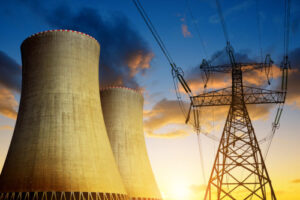While fossil fuels still provide the bulk of global energy, nuclear power is rapidly becoming the clean power solution countries need to meet increasing electricity demands while reducing emissions. As of 2021, more than 400 nuclear reactors are operating worldwide, providing approximately 10% of the world’s electricity. In the US alone, almost 1/5 of municipal electricity is produced by nuclear reactors.
During 2020 and 2021, nuclear power plants proved their ability to provide clean energy in the face of unprecedented labor shortages and fluctuating demand. The resiliency of nuclear power, coupled with its extremely low carbon footprint makes it one of the most sustainable solutions for clean energy production as the world transitions from fossil fuel energy production.
What Is Nuclear Power?
Nuclear power harnesses electricity from nuclear reactions caused by nuclear fission, fusion, or decay. Most nuclear power plants use nuclear fission to generate power from highly reactive elements such as uranium and plutonium.
How Nuclear Power Works
In nuclear science, fission is the process by which a nuclear source, such as uranium or plutonium, bombards nuclear fuel with neutrons. The bombardment causes the atoms in the fuel source to break down, or split, releasing more neutrons that collide with other atoms. The resultant chain reaction creates a massive amount of energy that heats water in the nuclear reactor. Spinning turbines convert the energy in the superheated water into kinetic energy which passes from the turbines to generators. The generators convert the rotary motion from the turbines into usable electricity for the grid.
Principles of Nuclear Power
Atoms are composed of electrons, protons, and neutrons, all held together by an extremely powerful force. Nuclear fuel elements like uranium and plutonium have heavier atoms with more subatomic particles that share weaker bonds. When fuel atoms are bombarded with neutrons, the bonds between the particles weaken and break, releasing that energy. Control rods made from absorbent elements such as silver and boron are used to absorb neutrons and control the chain reaction.
Uranium is one of the most abundant elements in the world, and as such, it has the capability to produce energy for generations. A single uranium pellet produces as much energy as 3 oil barrels with significantly less environmental impact. The abundance of nuclear energy sources make it a sustainable and efficient power generation option.
Developments in Nuclear Power
To provide sustainable energy, nuclear power must be able to scale to meet increasing demand, while ensuring cost-efficient operations. Advances in nuclear technology have increased the sustainability and efficiency of nuclear power plants. The nuclear power industry showed exceptional resilience in the face of the COVID-19 pandemic.
Nuclear technology continues to evolve to meet unexpected challenges. Some of the most notable developments in 2020 and 2021 include the development of Natrium and Xe-100 nuclear reactor designs, as well as the establishment of small modular reactors (SMRs).
To facilitate the development of more nuclear infrastructure, the US government has also introduced two legislative initiatives, the American Nuclear Infrastructure Act and the Fiscal Year 2022 budget which earmarks $1.85 billion for nuclear development. The bipartisan nature of these initiatives shows that, despite political differences, everyone recognizes the value of nuclear power generation in a changing world.
Benefits of Nuclear Power Today
Nuclear power offers many unique benefits over more traditional fossil fuel power generation methods. The primary advantages of transitioning to nuclear power include:
- Economic Support: Nuclear energy creates jobs for skilled workers with experience in the fossil fuel industry. Nuclear industry jobs pay more than coal and renewable energy sectors, and the industry provides approximately 500,000 jobs annually in the US alone. Each plant can employ hundreds of workers for the entire life of the plant and contributes billions of dollars in tax revenue on the local, state, and federal levels.
- Clean Energy: Nuclear power plants are the largest providers of emissions-free power in the US. Currently established nuclear reactors provide 800 billion kilowatt-hours of electricity annually, removing 470 million metric tons of potential carbon from our electricity generation cycle.
- Dependable Energy: Nuclear power facilities can operate at full power consistently for up to two years. They are designed to require low maintenance and infrequent refueling, which makes them an exceptionally reliable power source.
- Fosters International Cooperation: By incorporating civilian nuclear power into its energy grid, the US encourages countries around the world to establish peaceful nuclear power generation.
Cutting-Edge Nuclear Sources From Frontier Technology
After proving its resilience in the face of the COVID-19 pandemic, nuclear energy is poised to become the world’s leading source of emissions-free energy production. Advances in nuclear technology provide increasingly efficient, safe, and dependable solutions which allow countries to reduce emissions while meeting increasing demand.
At Frontier Technology, we offer a variety of nuclear power sources to facilitate the development and operation of clean nuclear energy, for a more sustainable future. Visit our website to learn more about our californium-252 solutions or contact us today!

